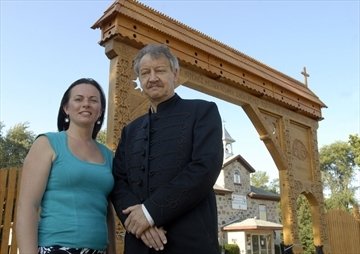Szekler gate: the largest and most complex gate of its kind in North America

An intricate wooden gate, carved by hand in a tradition passed down through generations, graces the entrance to the Hungarian Canadian Club of Waterloo-Wellington on Kossuth Road.
It was erected this summer, the vision of longtime club member Jeno Ankucza and the product of donations from generous members eager to honour the club’s 50th anniversary in 2012. “He dreamed of doing something significant for this anniversary,” said club president Tünde Volford, sitting alongside Ankucza at the hall. “It’s the start of the next 50 years.”
 The massive five-tonne ornamental gate was carved out of oak, using traditional techniques that require almost no hardware. A connected fence was built out of oak and pine. The style of gate is known as a Székely gate, named for — and familiar in — a region in present-day Romania inhabited largely by Hungarian people from eastern Transylvania. Professional woodcarvers Sándor Petho and Attila Borbandi, from the Transylvanian village of Torja, came to Cambridge to oversee the project.
The massive five-tonne ornamental gate was carved out of oak, using traditional techniques that require almost no hardware. A connected fence was built out of oak and pine. The style of gate is known as a Székely gate, named for — and familiar in — a region in present-day Romania inhabited largely by Hungarian people from eastern Transylvania. Professional woodcarvers Sándor Petho and Attila Borbandi, from the Transylvanian village of Torja, came to Cambridge to oversee the project.
“They were teaching us, showing us all the old ways,” Ankucza said, adding that at least 50 people worked on the project. “The beauty of it, they were young and old and anywhere in between,” he said. It took about five weeks to carve and construct the gate, once a design was finalized. The project was funded by private donations from club members, Volford said. Ariss Fencing loaned equipment and three employees to the project. Carvings on the gate and fence include a map of old Hungary with a coat of arms held by two angels, celestial symbols like the sun, moon and stars, rosettes and tulips.
The words of the Hungarian poet Daniel Berzsenyi are written along the top of the gate. Translated, they read “It is not by numbers but by soul and freedom that we can accomplish great things.” Another inscription on the gate reads: “To your ancestors’ holy faith and to your nation’s roots — brothers and sisters — never be unfaithful.”
Ankucza said it is the largest and most complex gate of its kind in North America. In addition to the gate and fence, a wooden monument to a pivotal Hungarian battle victory in the year 907 was also erected in front of the club. Acquired by about 100 Hungarian families in 1962, the club’s stone building, now known as Kossuth Hall, was originally built in the 1870s as a schoolhouse in the hamlet of Kossuth. Situated along the road from Preston to Guelph, the hamlet once boasted a pottery works, post office and a hotel.
According to the Waterloo Region Museum, the hamlet may have been named in honour of 19th-century Hungarian patriot Lajos Kossuth. However, the name could also have come from a landowner who owned properties in the settlement.
The club now has about 150 members, with many others who support its events. Volford and Ankucza said the new gate honours their past while looking to the future. “We would like to send a message to the original members that we are capable of continuing their great work,” Ankucza said.
Source: therecord.com





